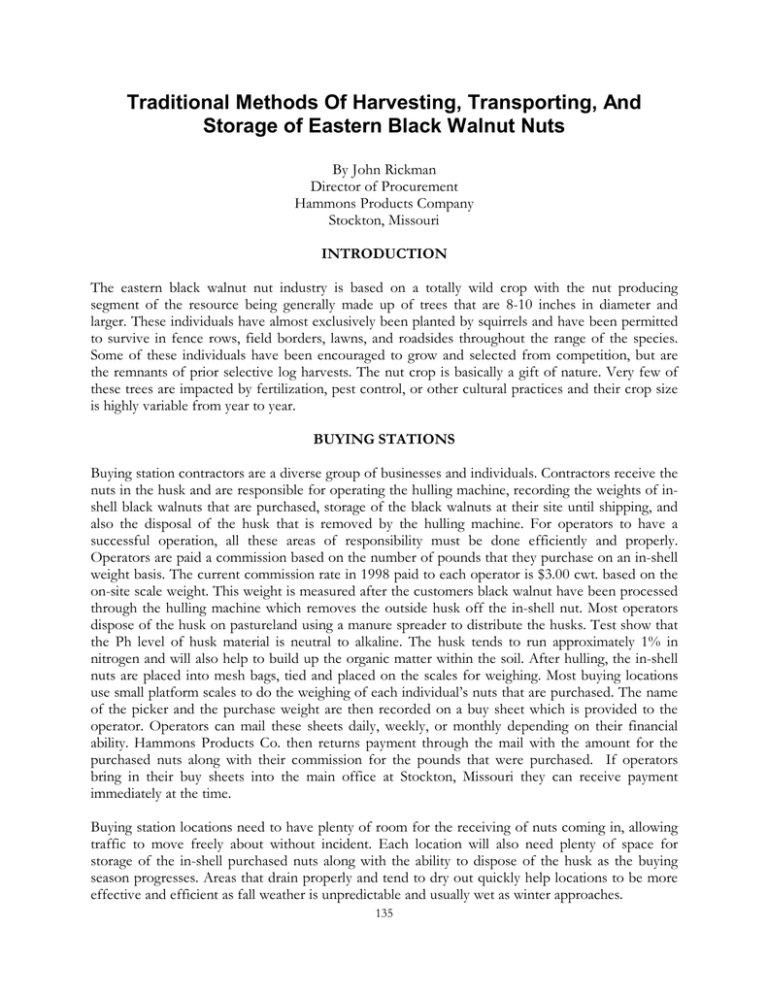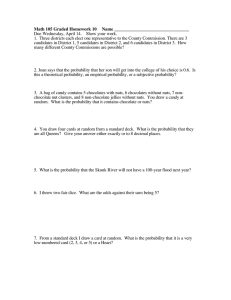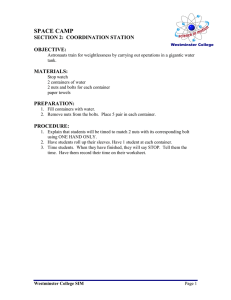Traditional Methods Of Harvesting, Transporting
advertisement

Traditional Methods Of Harvesting, Transporting, And Storage of Eastern Black Walnut Nuts By John Rickman Director of Procurement Hammons Products Company Stockton, Missouri INTRODUCTION The eastern black walnut nut industry is based on a totally wild crop with the nut producing segment of the resource being generally made up of trees that are 8-10 inches in diameter and larger. These individuals have almost exclusively been planted by squirrels and have been permitted to survive in fence rows, field borders, lawns, and roadsides throughout the range of the species. Some of these individuals have been encouraged to grow and selected from competition, but are the remnants of prior selective log harvests. The nut crop is basically a gift of nature. Very few of these trees are impacted by fertilization, pest control, or other cultural practices and their crop size is highly variable from year to year. BUYING STATIONS Buying station contractors are a diverse group of businesses and individuals. Contractors receive the nuts in the husk and are responsible for operating the hulling machine, recording the weights of inshell black walnuts that are purchased, storage of the black walnuts at their site until shipping, and also the disposal of the husk that is removed by the hulling machine. For operators to have a successful operation, all these areas of responsibility must be done efficiently and properly. Operators are paid a commission based on the number of pounds that they purchase on an in-shell weight basis. The current commission rate in 1998 paid to each operator is $3.00 cwt. based on the on-site scale weight. This weight is measured after the customers black walnut have been processed through the hulling machine which removes the outside husk off the in-shell nut. Most operators dispose of the husk on pastureland using a manure spreader to distribute the husks. Test show that the Ph level of husk material is neutral to alkaline. The husk tends to run approximately 1% in nitrogen and will also help to build up the organic matter within the soil. After hulling, the in-shell nuts are placed into mesh bags, tied and placed on the scales for weighing. Most buying locations use small platform scales to do the weighing of each individual’s nuts that are purchased. The name of the picker and the purchase weight are then recorded on a buy sheet which is provided to the operator. Operators can mail these sheets daily, weekly, or monthly depending on their financial ability. Hammons Products Co. then returns payment through the mail with the amount for the purchased nuts along with their commission for the pounds that were purchased. If operators bring in their buy sheets into the main office at Stockton, Missouri they can receive payment immediately at the time. Buying station locations need to have plenty of room for the receiving of nuts coming in, allowing traffic to move freely about without incident. Each location will also need plenty of space for storage of the in-shell purchased nuts along with the ability to dispose of the husk as the buying season progresses. Areas that drain properly and tend to dry out quickly help locations to be more effective and efficient as fall weather is unpredictable and usually wet as winter approaches. 135 HARVEST SEASON AND HARVESTING METHODS The eastern Black Walnut buying season begins October 1st each year and extends into the second or third week of November. With the buy season only five to six weeks in length, this makes for very intense and aggressive harvest. The volume of nuts needed and purchased each year is not controlled by the length of the buying season, but more by the suggested purchase price of the nuts at the buying locations. Current pricing is based on supply and demand and flexible pricing is being implemented on a more regular basis each new year. However, Mother Nature plays a very large and important role in the volume and quality of crop that is available for purchase. Through the years, the black walnut nut industry has not changed much in the way the nuts are harvested. Usually in late September to early October the nuts mature and drop to the ground where they are still picked up by hand one at a time. This is a very labor intense harvesting method and currently continues to remain that way. The nuts are picked from under trees located in fence rows, pasture land, lawns, and even black walnut orchards throughout the Midwest and eastern United States. STORAGE AND TRANSPORTATION Storage and handling of the bagged in-shell nuts is one of the most important areas of responsibility that the operator has. Operators need to place the bags on pallets, and store the nuts outside which helps air to circulate through out the mesh bags and begins the drying out process. Although the nuts may get rained on in an outdoor storage location, they will quickly begin drying as a result of outside air movements. When the in-shell nuts are stored in a confined space without air movement, the nut will begin showing signs of mold on the shell. The kernel will then begin pulling moisture from the outside shell into the kernel, thus increasing the kernels moisture content and prohibiting proper drying. Over extended periods of time in this situation, the kernel will begin turning darker in color and becoming poor in quality. Locations which buy large amounts of black walnuts quickly realize how much labor and space is needed to handle and store large volumes of this tasty nut. Mesh bags are then loaded on or into trailers and transported to the shelling facility for further processing. All bags are normally loaded and unloaded by hand both at on-site buying location and at the shelling facility. Using this process on literally millions of pounds of in-shell nuts is a very strenuous and a highly laborious effort not only at the operator level, but at the shelling plant as well. PLANNING FOR THE FUTURE With more eastern black walnut orchards being planted each year, advanced harvest techniques along with improved handling practices must be improved upon in the near future. Implementations of new purchasing procedures dealing with percent yields, moisture content, and kernel color are all areas that will need to be explored and expanded on. Advancements in tree genetics for nut production will need to reach levels where land owners are willing and wanting to plant eastern black walnut trees for a cash crop with returns on a per acre basis being equal to other agricultural commodities. When all of these new practices and procedures are in place, the black walnut nut producing industry will truly reach commercialization levels. 136



